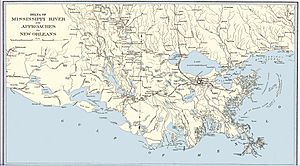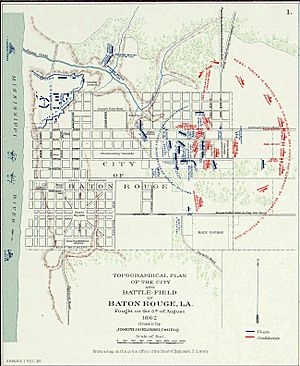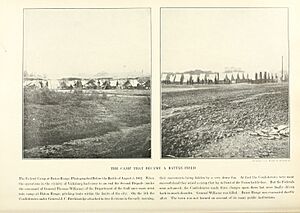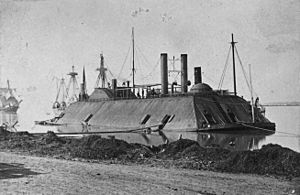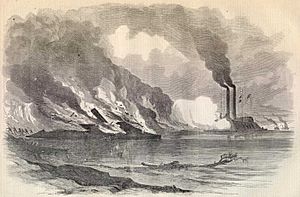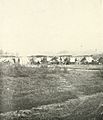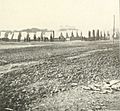Battle of Baton Rouge (1862) facts for kids
Quick facts for kids Battle of Baton Rouge |
|||||||
|---|---|---|---|---|---|---|---|
| Part of the Trans-Mississippi Theater of the American Civil War |
|||||||
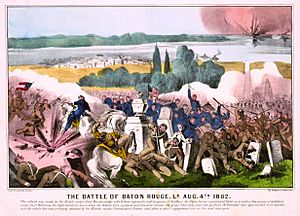 The Battle of Baton Rouge by Currier & Ives |
|||||||
|
|||||||
| Belligerents | |||||||
| Commanders and leaders | |||||||
| Thomas Williams † Thomas W. Cahill |
John C. Breckinridge Charles W. Read Charles Clark (POW) |
||||||
| Strength | |||||||
| 2,500 | 2,600 | ||||||
| Casualties and losses | |||||||
| 371 killed, wounded and missing | 478 killed, wounded and missing | ||||||
The Battle of Baton Rouge was an important fight during the American Civil War. It happened on August 5, 1862, in East Baton Rouge Parish, Louisiana. This battle involved both land forces and naval ships.
The Union army won this battle. Their victory stopped the Confederate forces from taking back Baton Rouge. At the time, Baton Rouge was the capital city of Louisiana.
Contents
Why the Battle Happened
In April 1862, the Union Navy, led by Admiral David Farragut, captured New Orleans. This was a big win for the Union. Because of this, the Confederate government in Louisiana decided to leave Baton Rouge. They moved their capital to other cities.
On May 9, a Union naval officer took control of the military buildings in Baton Rouge without a fight. Later, some local fighters attacked a Union boat. In response, Admiral Farragut's ship fired cannons at the town. This caused damage and hurt some civilians.
On May 29, Union Brigadier General Thomas Williams arrived. He brought many soldiers and began to occupy Baton Rouge.
During the summer, Confederate Major General Earl Van Dorn wanted to take Baton Rouge back. He believed that getting Baton Rouge back would help the Confederates push the Union out of Louisiana. It would also let them attack Union areas along the Red River. This would threaten the Union's control of New Orleans.
About 5,000 Confederate soldiers, led by Major General John C. Breckinridge, traveled to Camp Moore. They were joined by more soldiers there. At the same time, the Confederate ironclad ship Arkansas was sailing down the Mississippi River. Its goal was to fight Union ships near Baton Rouge.
General Williams, the Union commander, knew the Confederates were coming. On August 4, Union troops got ready outside Baton Rouge. Many of the Union soldiers were new and had only been training for two weeks. They also did not have many supplies.
The Battle Begins
Breckinridge's Confederate troops moved close to Baton Rouge by August 4. They marched even closer during the night. However, Union guards discovered them, so the Confederates lost the element of surprise. Even so, the attack started at dawn on August 5.
The Union troops were in the middle of Baton Rouge. The Confederates were lined up in two groups north of the city. The fighting happened around Florida Street. The Confederates pushed the Union soldiers back across the town. There was fierce fighting, especially near Magnolia Cemetery.
During the battle, the Union commander, Brigadier General Thomas Williams, was killed. Colonel Thomas W. Cahill then took command of the Union forces.
Colonel Cahill led his troops back to strong defensive lines near the Penitentiary. These lines were protected by Union warships. The Confederate troops then started to face fire from the Union gunboats.
The Confederate ironclad Arkansas arrived soon after. It was supposed to fight the Union ironclad USS Essex. But the Arkansas's engines stopped working just a few miles from the city. Its commander ordered the ship to be set on fire. This was done to prevent the Union from capturing it.
Without any help from their navy, General Breckinridge could not attack the strong Union positions. So, he pulled his troops back. The Union troops left Baton Rouge a week later. They were worried about the safety of New Orleans. However, they returned to Baton Rouge that autumn. The Confederates then took control of Port Hudson, which they held for almost another year.
Every year, a special ceremony is held to remember the Battle of Baton Rouge. It takes place on the first Saturday in August at Magnolia Cemetery.
Who Fought in the Battle
Union Forces
The Union forces were led by Brigadier General Thomas Williams, and then by Colonel Thomas W. Cahill after Williams was killed.
- Infantry Regiments:
* 9th Connecticut Infantry * 21st Indiana Infantry * 14th Maine Infantry * 30th Massachusetts Infantry * 6th Michigan Infantry * 7th Vermont Infantry * 4th Wisconsin Infantry
- Artillery:
* Indiana Battery * 2nd Battery, Massachusetts Light Artillery * 4th Battery, Massachusetts Light Artillery * 6th Battery, Massachusetts Light Artillery
- Union Navy Ships:
* USS Hartford * USS Westfield * USS Jackson * USS Cayuga * USS Katahdin * USS Brooklyn * USS Clifton * USS Sciota * USS Kineo * USS Essex

Confederate Forces
The Confederate forces were led by Major General John C. Breckinridge.
- Infantry Divisions:
* First Division, led by Brigadier General Charles Clark * Second Division, led by Brigadier General Daniel Ruggles
- Confederate Navy Ship:
* CSS Arkansas
Images for kids


